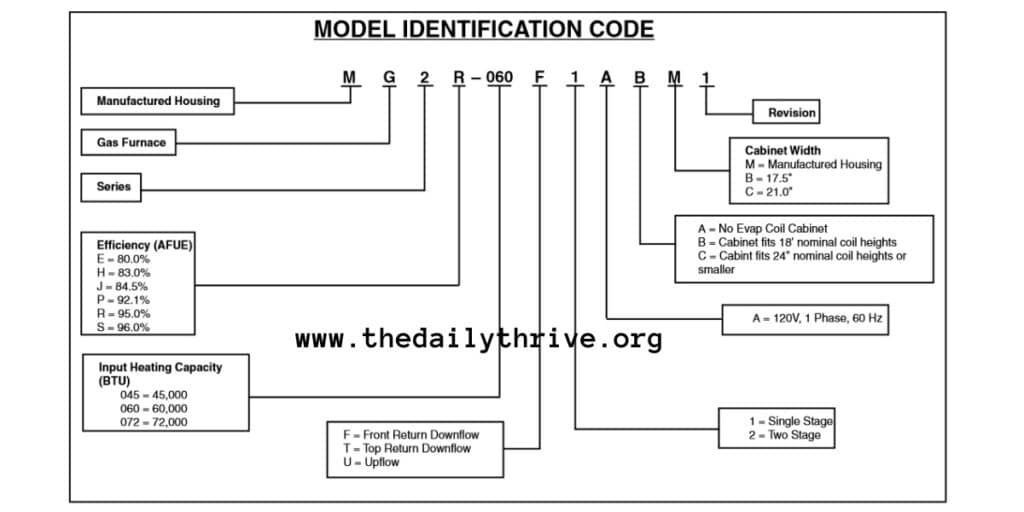One critical yet often overlooked detail in the care and maintenance of any furnace is the model number. For Intertherm furnaces, this number is more than a simple identifier—it is an essential key that unlocks vital data and resources for your heating system. In this article, I will cover everything you need to know about the Intertherm furnace model number and its significance in ensuring your system operates efficiently and effectively.
Why the Model Number Matters
The model number on your Intertherm furnace functions like a detailed map, serving several crucial roles. Foremost is the identification of correct replacement parts.
Furnaces are complex machines with components precisely engineered for specific models. Using the right parts ensures compatibility and prevents malfunctions that arise from using incompatible components. It also guarantees that the furnace’s efficiency and longevity are not compromised by ill-fitting parts, which could cause additional damage or reduced performance.
Beyond maintenance practicalities, the model number can indicate the furnace’s tonnage, which measures its heating capacity (often referred to in terms of BTU output). Understanding tonnage is essential when determining if a furnace is suitably sized for your home. An incorrectly sized furnace can lead to inefficiencies; a unit that is too large or too small for the space it serves results in increased wear and tear, higher energy costs, and uneven heating.
Furthermore, administrative tasks such as registering your furnace for warranty purposes or claiming warranty service often require the model number. Warranties may cover various parts for differing lengths of time, and having the model number readily available streamlines the process of verifying coverage and ensuring you receive the entitled services or replacements.
The model number also enables HVAC professionals to access the historical data and technical specifications of your furnace, which is invaluable for troubleshooting. It provides a quick reference to the unit’s age, technological features, and operational guidelines, all of which contribute to a more efficient diagnosis and service.
The furnace model number is a gateway to a wealth of information essential for proper furnace care and management. It simplifies the maintenance process, from the practicalities of repair and replacement to the necessities of warranty and service, ensuring your heating system remains in optimal condition.
Locating the Intertherm Furnace Model Number
Finding your Intertherm furnace’s model number is straightforward. It’s typically located on a metal plate or sticker inside the furnace’s front access panel. This data tag also contain the serial number.
To locate it, you’ll need to:
- Turn off your furnace for safety.
- Remove the front panel—this might require unscrewing or simply lifting off, depending on the model.
- Look for a sticker or plate that lists the model number, often near the top or on the side of the interior.
Intertherm Furnace Model Number Lookup
Reading the Intertherm furnace model number can seem a bit confusing at first, but it’s just about breaking down the information into understandable parts. Manufacturers encode specific information about the furnace within the model number, such as the type, capacity, efficiency, and series.
For example MG2R060F1ABM1

How to read the Intertherm furnace model number?
Let’s delve into each specification listed in the Intertherm furnace model number and explain what they represent:
- Manufactured Housing (First Letter – ‘M’): This indicates that the furnace is designed specifically for use in manufactured homes, which may require different specifications due to space constraints and ventilation systems.
- Gas Furnace (Second Letter – ‘G’): This specifies that the appliance is a gas furnace using natural gas as its fuel source.
- Series (Numerical Value): The series number provides information about the design and technological generation of the furnace. It can often be related to the release or production year, indicating the age and features of the model.
- Efficiency (AFUE) (Letter after Series): This letter corresponds to the Annual Fuel Utilization Efficiency percentage, indicating how well the furnace converts gas into heating energy. Higher percentages represent more efficient furnaces.
- Input Heating Capacity (BTU) (Three-digit Number): This number represents the furnace’s heating capacity in British Thermal Units. It determines how much heat the furnace can produce and is a crucial factor for sizing the unit to your home’s heating requirements.
- Airflow Configuration (Letter’ F’, ‘T’, or ‘U’):
- ‘F’ stands for Front Return Downflow,
- ‘T’ for Top Return Downflow,
- ‘U’ for Upflow. This specifies the direction in which air moves through the furnace and is essential for matching the furnace to the home’s ductwork layout.
- Cabinet Width (Letter’ M’, ‘B’, or ‘C’):
- ‘M’ indicates the furnace is designed for Manufactured Housing,
- ‘B’ signifies a cabinet width of 17.5 inches,
- ‘C’ represents a cabinet width of 21.0 inches. This information helps ensure the furnace will fit in the allocated space.
- Evaporator Coil Cabinet (Letter ‘A,’ ‘B,’ or ‘C’):
- ‘A’ means there is no Evaporator Coil Cabinet,
- ‘B’ indicates the cabinet fits 18″ nominal coil heights,
- ‘C’ means the cabinet fits 24″ nominal coil heights or smaller. This is significant for those installing or maintaining an air conditioning system in conjunction with the furnace.
- Electrical Specifications (Letter ‘A’): The ‘A’ at this position in the model number refers to the electrical requirements of the furnace, such as 120V, 1 Phase, and 60 Hz. This is crucial for ensuring electrical compatibility and safety.
- Operational Mode (Numerical Value ‘1’ or ‘2’):
- ‘1’ represents a Single Stage operation, where the furnace operates at one level of heating output.
- ‘2’ indicates a Two-stage operation, which means the furnace can adjust its output between two levels for more efficient heating and better temperature control.
Each component of the Intertherm furnace model number is an integral part of understanding your furnace’s identity, ensuring you can effectively communicate your furnace’s specifications for servicing, troubleshooting, and when seeking support or parts.
How Can You Determine the Tonnage of Your Intertherm Furnace from the Model Number?
In residential HVAC terminology, tonnage refers to the cooling capacity of an air conditioning system and isn’t directly used for furnaces. However, the heating capacity of a furnace is usually indicated in BTUs (British Thermal Units) per hour. Intertherm furnace model numbers typically include a three-digit number that signifies the input heating capacity in thousands of BTUs.
To extrapolate the equivalent “tonnage” from this BTU figure, you would typically apply it to air conditioning units where 12,000 BTUs is equivalent to one ton. Furnaces, being primarily heating units, don’t use this measure, but if you need to find the tonnage for the purpose of understanding the capacity of a combined HVAC system (including both heating and cooling), you could use this method.
Here’s how you can approximate the tonnage from the BTU rating given in the furnace model number:
- Locate the three-digit number in the model number that indicates the BTU capacity.
- Divide this number by 12 (since there are 12,000 BTUs in one ton of cooling capacity).
For example, if the model number of an Intertherm furnace includes the number 060, this would mean the furnace has an input heating capacity of 60,000 BTUs per hour.
To find the tonnage, you would perform the following calculation:
60,000 BTUs / 12,000 BTUs per ton = 5 tons
Remember, this is not a standard way to describe a furnace’s capacity, but it could be useful for understanding the potential cooling capacity of an air conditioning system that’s part of the same HVAC setup or if you’re trying to gauge the overall energy capabilities of your combined heating and cooling system.
Summary
With your model number in hand, you can accurately seek technical support, order the correct parts, or even troubleshoot some common issues. This number ensures that any components you purchase will be compatible with your specific furnace.
I always advise clients to keep a record of their furnace’s model number. Write it down and keep it with your other home maintenance documents. It’s a simple step that can save time and confusion in the future.
Knowing and understanding your Intertherm furnace model number is an invaluable part of HVAC maintenance. It helps technicians like myself quickly identify the specifics of your furnace, facilitating efficient and accurate service. Keep this number handy, and you’ll be well-prepared for any maintenance or repair needs that arise.






